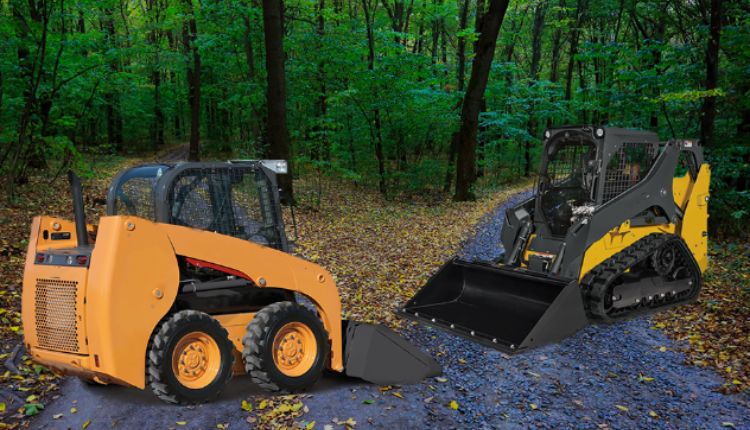When planning a construction, landscaping, or site prep project, choosing the right equipment can save time, money, and a lot of effort. Two of the most popular and versatile pieces of compact machinery are the skid steer and the track loader. At first glance, they may appear quite similar, but their performance, traction, and application can differ significantly depending on your jobsite needs.
If you’re considering a skid steer rental or weighing the pros and cons of a track loader, understanding how these machines function—and how they differ—can help you make the best decision for your project. In this guide, we’ll break down the features, advantages, and ideal use cases for both types of machines.
What Is a Skid Steer?
A skid steer is a compact loader equipped with four wheels and a fixed frame. It turns by skidding or dragging its wheels on one side while the other side turns at a different speed or in the opposite direction. This gives the skid steer its name and allows it to make tight turns in confined spaces.
Common Uses for Skid Steers:
- Loading and unloading materials
- Grading and leveling
- Light demolition work
- Snow removal
- Landscaping projects in confined areas
Skid steers are known for their agility and speed, making them ideal for job sites where maneuverability is essential.
What Is a Track Loader?
A track loader is similar in function and appearance to a skid steer but runs on rubber or steel tracks instead of wheels. The tracked undercarriage provides enhanced traction and stability, especially on uneven or soft terrain.
Common Uses for Track Loaders:
- Site preparation on muddy or sloped ground
- Excavating and backfilling
- Material transport over rough or wet terrain
- Landscaping large areas
- Grading on soft or sandy soil
Track loaders are often considered more versatile when working in challenging environmental conditions.
Key Differences Between Skid Steers and Track Loaders
While both machines offer a wide range of applications and attachment compatibility, they differ in several important ways that affect performance and suitability.
1. Traction and Stability
- Skid Steer: Performs well on hard, dry, and even surfaces like asphalt or compacted dirt. However, it may struggle with traction on loose, muddy, or snowy ground.
- Track Loader: Provides superior traction on soft, wet, or sloped terrain. The tracks distribute weight more evenly, which helps prevent sinking or slippage.
If you’re working in wet spring conditions or on freshly graded soil, a track loader may offer better reliability throughout the job.
2. Ground Pressure
- Skid Steer: Exerts more ground pressure due to its weight being concentrated on four wheels. This can lead to damage on landscaped or soft areas.
- Track Loader: Distributes weight over a larger area, reducing ground pressure and minimizing surface damage.
For jobs around existing lawns, gardens, or sensitive surfaces, a track loader is typically the safer option.
3. Speed and Maneuverability
- Skid Steer: Generally faster and easier to maneuver, especially on firm surfaces or paved sites.
- Track Loader: Slower and more deliberate in movement, but offers better control on rough terrain.
If your project involves frequent repositioning or navigating tight urban lots, a skid steer rental might be the better fit.
4. Maintenance and Longevity
- Skid Steer: Wheels are easier and less expensive to maintain or replace than tracks. These machines often hold up well in environments with less abrasive terrain.
- Track Loader: Tracks require more maintenance and cost more to replace, especially if used on abrasive surfaces like concrete or gravel.
If your job involves mostly hard, flat surfaces, using a skid steer will likely reduce wear and tear costs over time.
5. Cost of Rental and Operation
- Skid Steer: Usually less expensive to rent and operate. Great for short-term or budget-conscious projects.
- Track Loader: Higher rental rates due to added traction and capability but may provide better value in tough conditions.
Rental companies often recommend evaluating your terrain first before committing to one over the other. In many cases, a skid steer rental is more than sufficient for general construction or light landscaping work.
Attachment Compatibility
One reason both skid steers and track loaders are so popular is their ability to accept a wide variety of attachments. This makes them versatile tools on nearly any jobsite.
Common Attachments for Both Machines:
- Buckets (standard, 4-in-1, rock buckets)
- Augers for drilling
- Grapples for brush or debris
- Forks for lifting pallets
- Trenchers and grading blades
- Snowblowers and sweepers
Most attachments are interchangeable between the two machine types, especially if they share the same quick-attach system. So, your decision may ultimately come down to terrain and operating conditions rather than versatility.
Which Machine Is Right for Your Project?
Choose a Skid Steer If:
- You’re working on hard, dry, and even surfaces
- The project is in an urban or confined area
- You need speed and frequent machine repositioning
- You want to minimize rental and maintenance costs
- Your job involves a lot of surface-level tasks or loading/unloading materials
A skid steer rental is especially effective for short-duration projects that require a quick, responsive machine.
Choose a Track Loader If:
- Your jobsite has soft, wet, or uneven terrain
- You’re working on a slope or need extra traction
- You want to reduce ground disturbance on finished surfaces
- Your project involves more demanding site prep or heavy lifting
- You expect to use the machine continuously over several days or weeks
Track loaders are especially beneficial during unpredictable weather or on undeveloped land with loose soil.
Final Thoughts
While skid steers and track loaders share many characteristics, understanding their differences is essential for choosing the right equipment for your jobsite. Skid steers offer maneuverability, cost savings, and speed for light-to-medium jobs on solid ground. Track loaders provide superior stability and performance on uneven, wet, or delicate terrain.
If you’re still unsure which option is best, consult your equipment rental provider. They can evaluate your project’s scope, location, and surface conditions to help you select the right machine—and the right attachments—for maximum productivity.
Whichever route you go, choosing between a track loader and a skid steer rental doesn’t have to be complicated. It just requires a little planning and a clear understanding of your site conditions.






